


Biking, a popular form of exercise and transportation, has long been praised for its numerous health benefits. However, concerns have arisen about its potential impact on knee health.
Related : ” Is Cycling Harmful For Knees? ”
Many enthusiasts and beginners alike wonder, “Is biking hard on knees?”
In this comprehensive discussion, we will delve into the effects of cycling on knee joints, explore factors that contribute to knee strain, and provide valuable tips to mitigate any potential risks.
Understanding how to protect your knees while enjoying the joy of biking is essential for maintaining a healthy, active lifestyle.
So, let’s pedal through the details and uncover the truth about the impact of biking on your knee health.
Exploring the Impact of Biking on Knee Health
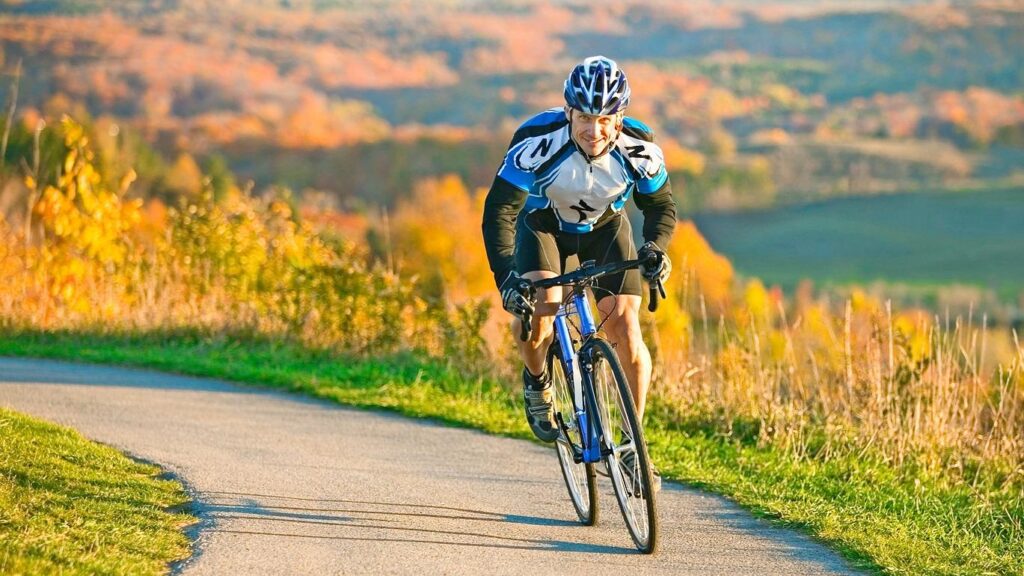


Biking, whether on a road bike, mountain bike, or any other type, can have varying impacts on knee health depending on several factors.
While cycling is generally considered a low-impact exercise that is gentle on the knees compared to activities like running, improper form or bike fit can lead to knee discomfort or injury.
Exploring the impact of biking on knee health involves understanding the biomechanics of cycling.
Pedaling requires the repetitive motion of bending and straightening the knees, which, if not done correctly, can strain the joint. Moreover, overuse or excessive training without proper rest can contribute to knee issues.
However, biking also offers benefits for knee health. It is a non-weight-bearing activity, reducing the stress on knee joints.
Furthermore, it can improve the strength and flexibility of the surrounding muscles, such as the quadriceps and hamstrings, which support the knees.
To ensure biking is knee-friendly, cyclists should maintain proper bike fit, adjust saddle height, and use correct pedaling techniques.
Regular stretching and strengthening exercises can help prevent knee problems and ensure an enjoyable and injury-free biking experience.
If any persistent discomfort or pain occurs, seeking advice from a healthcare professional is essential to address potential issues promptly.
Related: Is biking good for knee pain?
The Mechanics of Cycling: Understanding Knee Movements



Understanding the mechanics of cycling and how it affects knee movements is crucial for preventing knee injuries and discomfort during biking.
Read More : ” Riding A Bike On Road Hard? “
The knee joint is a hinge joint, allowing flexion and extension during the pedaling motion.
During cycling, the knee undergoes repetitive bending and straightening as the pedal moves in a circular motion.
This motion is facilitated by the quadriceps and hamstrings, the muscles responsible for extending and flexing the knee, respectively. Additionally, the patella (kneecap) glides over the femur, contributing to the smooth movement.
Proper bike fit is essential for optimal knee mechanics. When the saddle height is too low, it can lead to excessive bending of the knee, causing strain.
Conversely, if the saddle is too high, it can overextend the knee and lead to discomfort. Correct pedal placement and proper foot alignment can also impact knee movements positively.
It’s crucial for cyclists to maintain a cadence (pedal revolutions per minute) that suits their fitness level and riding style.
Lower cadences with higher resistance can place more stress on the knees, while faster cadences with lower resistance may reduce strain.
Understanding knee movements in cycling allows cyclists to make adjustments to their bike fit, pedaling technique, and cadence to promote smooth and efficient knee mechanics.
This knowledge, coupled with proper training and conditioning, can help ensure a safe and enjoyable biking experience while minimizing the risk of knee-related issues.
The Low-Impact Advantage: How Biking is Gentle on Knees
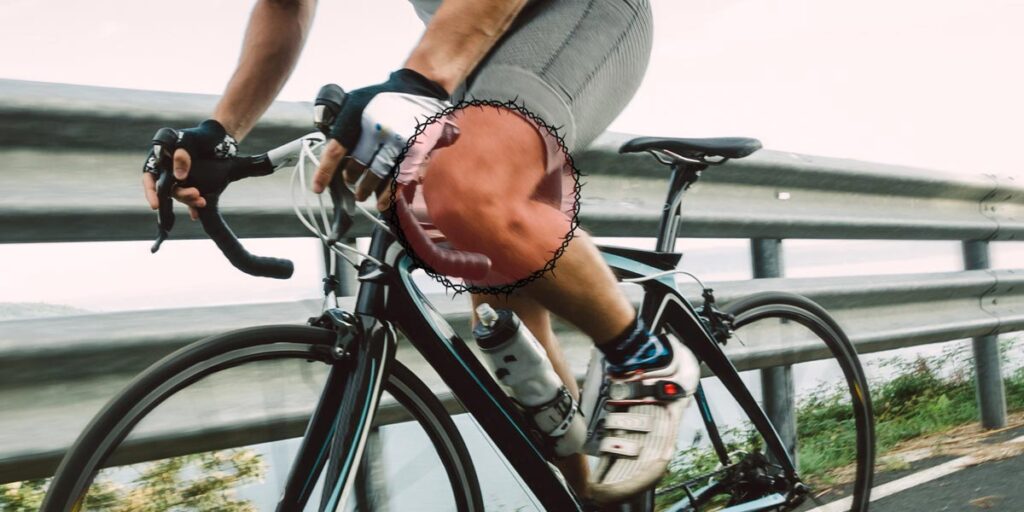


Biking is often considered a low-impact exercise, which means it places minimal stress on the joints, including the knees.
Read More : ” Why Are Mountain Bikes So Expensive “
This low-impact advantage is one of the reasons why biking is generally gentle on the knees compared to other high-impact activities like running or jumping.
Here’s how biking offers a low-impact advantage for knee health:
Reduced Joint Impact:
Unlike high-impact exercises, such as running, where the feet repeatedly strike the ground, biking involves smooth, circular motions that significantly reduce the impact on the knees and other joints.
The bike’s wheels absorb most of the shock, making it a more joint-friendly activity.
Controlled Range of Motion:
Biking allows the knees to move through a controlled range of motion, promoting flexibility and strength without subjecting the joint to excessive stress.
The repetitive and fluid pedaling motion is less likely to cause sudden and jarring movements that could strain the knees.
Adjustable Intensity:
Cyclists can adjust the intensity of their ride by modifying resistance or speed.
Lowering the resistance or choosing flatter terrains can further reduce the stress on the knees, making biking suitable for individuals with varying fitness levels or knee conditions.
Muscle Support:
Biking engages various muscle groups, including the quadriceps, hamstrings, and glutes. Strong muscles around the knees provide better support and stability, reducing the load on the joint and minimizing the risk of injury.
Weight-Bearing Exercise:
While biking is low-impact, it is still a weight-bearing exercise, which helps maintain bone density and supports overall joint health.
It’s important to note that individual factors, such as pre-existing knee conditions or improper bike fit, can influence how the knees respond to cycling.
Ensuring proper bike fit, using appropriate gear, and listening to the body are essential for a safe and knee-friendly biking experience.
As with any exercise, consulting with a healthcare professional before starting a biking routine is recommended, especially if there are pre-existing knee concerns.
Proper Bike Fit: Ensuring Knee-Friendly Cycling
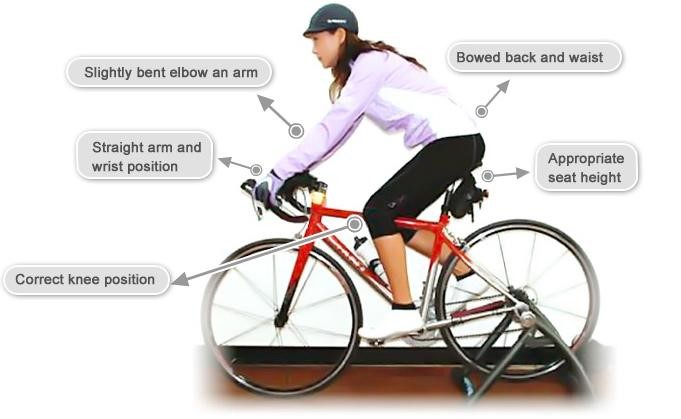


Proper bike fit is crucial for ensuring knee-friendly cycling and preventing potential knee issues.
Read More : ” How To Clean A Mountain Bike? “
When the bike is adjusted correctly to match your body measurements and riding style, it minimizes stress on the knees and promotes a more comfortable and efficient cycling experience.
Here’s how to achieve proper bike fit:
Frame Size:
Choose a bike frame size that suits your height and leg length. Incorrect frame size can lead to overextending or bending the knees excessively, causing discomfort and potential injuries.
Saddle Height:
Adjust the saddle height to allow a slight bend in your knee when the pedal is at the lowest position. A straight leg at the bottom of the pedal stroke can strain the knee joint.
Saddle Position:
The saddle should be positioned horizontally to support your sit bones evenly. A tilted saddle can lead to uneven weight distribution and pressure on the knees.
Handlebar Height:
Adjust the handlebar height to a position that allows a comfortable riding posture. An excessively low or high handlebar can create additional strain on the knees.
Cleat Alignment:
If you use clip-in pedals with cycling shoes, ensure that the cleats are properly aligned with your natural foot position. Misaligned cleats can cause knee pain and instability during pedaling.
Crank Length:
Consider the crank length that suits your leg length and pedaling style. Shorter or longer cranks may affect knee biomechanics.
Reach and Stem Length:
Adjust the stem length to achieve a comfortable reach to the handlebars. Improper reach can lead to awkward knee positions and discomfort.
Regular Maintenance:
Ensure your bike is well-maintained, with properly functioning brakes and gears. A well-tuned bike reduces the risk of sudden movements or mishaps that could impact the knees.
Listen to Your Body:
Pay attention to any discomfort or pain during cycling. If you experience knee pain, stop riding and identify the cause. Addressing issues early can prevent more significant problems.
Professional Bike Fit:
Consider getting a professional bike fit from a certified bike fitter. They can assess your body’s biomechanics and tailor the bike setup to your specific needs, ensuring optimal knee alignment and efficiency.
A well-fitted bike encourages proper knee alignment, reduces strain, and enhances the overall cycling experience.
Remember, individual factors and preferences may vary, so it’s essential to find a bike fit that works best for you and promotes knee-friendly cycling.
Pedaling Techniques: Reducing Stress on the Knees



Pedaling techniques play a significant role in reducing stress on the knees while cycling. Proper pedaling mechanics can improve efficiency, reduce fatigue, and minimize the risk of knee injuries.
Read More : ” How To Adjust Gear Shifter On Bike? “
Here’s how to pedal effectively and protect your knees:
Smooth Pedaling:
Aim for smooth and even pedaling strokes. Avoid applying excessive force at any point during the pedal stroke. A circular and fluid motion helps distribute the workload across muscles and joints, including the knees.
Maintain Cadence:
Focus on maintaining a consistent cadence (pedal revolutions per minute). A cadence between 80 to 100 RPM is generally recommended for most cyclists, as it reduces pressure on the knees compared to slower, more forceful pedaling.
Gear Selection:
Use appropriate gears for the terrain and your fitness level. Shift to lower gears when climbing or riding at slower speeds to reduce the strain on your knees.
Conversely, use higher gears for faster, flatter sections to maintain a comfortable cadence.
Avoid High Gear/Forceful Standing:
Refrain from riding in high gears while standing and mashing down on the pedals. This places excessive stress on the knees and can lead to overuse injuries.
Cleat Position:
If you use clip-in pedals, ensure that your cleats are positioned correctly. Proper cleat alignment can optimize knee tracking during the pedal stroke and reduce lateral knee stress.
Relax Your Ankles:
Keep your ankles relaxed during the pedal stroke. Avoid pointing your toes downward, as this can strain the knees. Instead, focus on a neutral foot position throughout the rotation.
Seat Position:
Adjust your seat height and fore-aft position to achieve the optimal knee angle during the pedal stroke. Your knee should have a slight bend at the bottom of the stroke to prevent hyperextension.
Listen to Your Body:
Pay attention to any signs of discomfort or pain in your knees while cycling. If you experience knee pain, rest and address the issue before resuming riding.
Warm-up and Stretch:
Before cycling, perform dynamic warm-up exercises and gentle stretches to prepare your muscles, including those around the knees, for the activity.
Strength Training:
Include off-the-bike strength training exercises that target the muscles supporting your knees, such as quads, hamstrings, and glutes. Strengthening these muscles can enhance knee stability during pedaling.
Remember that individual factors, such as pre-existing knee conditions or body mechanics, can also influence pedaling techniques.
If you have persistent knee pain or concerns, consult a sports medicine professional or bike fit specialist for personalized guidance and recommendations.
By adopting proper pedaling techniques, you can minimize stress on your knees and enjoy a comfortable and enjoyable cycling experience.
Common Knee Issues in Cycling: Causes and Prevention
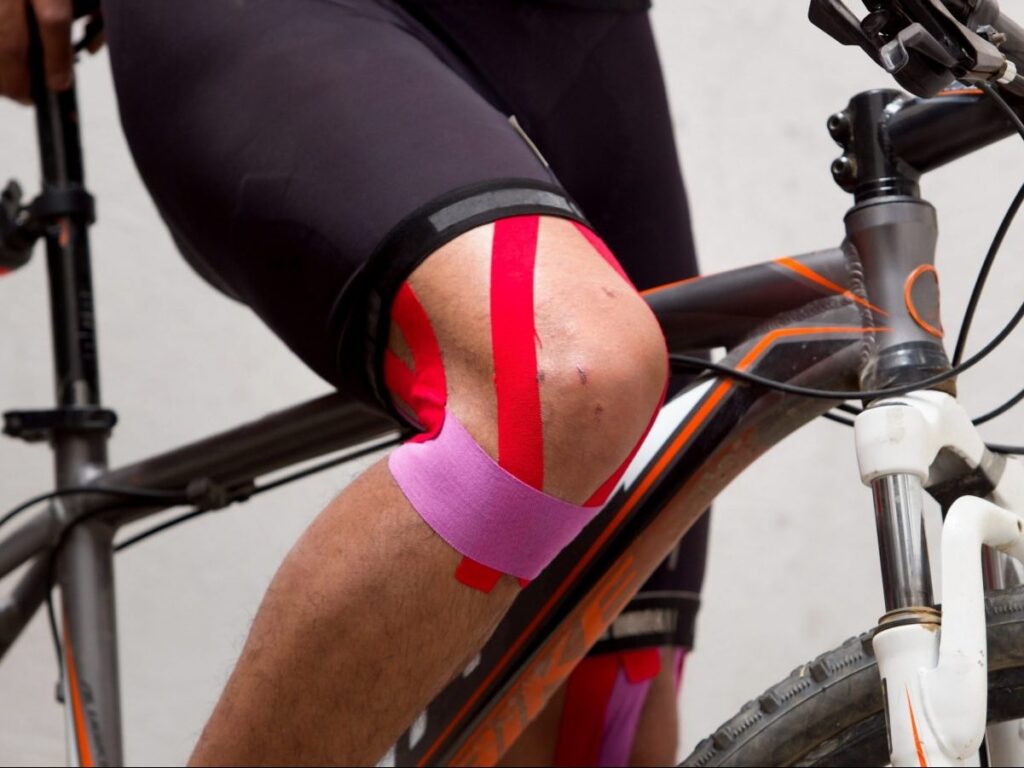


Cycling is generally considered a low-impact activity that is easy on the knees. However, like any repetitive motion, it can lead to certain knee issues.
Here are some common knee problems in cycling, their causes, and prevention strategies:
Patellofemoral Pain Syndrome (PFPS)
Also known as “cyclist’s knee,” PFPS is characterized by pain around or behind the kneecap. It often results from misalignment of the kneecap, overuse, or muscular imbalances.
Preventive measures include proper bike fit, strengthening quadriceps and hip muscles, and avoiding excessive hill climbing.
Iliotibial Band Syndrome (ITBS)
ITBS is caused by inflammation of the iliotibial band, a connective tissue running along the outside of the thigh. It can lead to pain on the outer knee.
Prevent ITBS by maintaining proper bike fit, stretching and foam rolling the IT band, and avoiding sudden increases in mileage.
Meniscus Injuries
The meniscus is a cartilage in the knee that can be damaged due to twisting or overloading the joint.
Prevention involves strengthening leg muscles, using proper riding techniques, and avoiding extreme impacts.
Patellar Tendinitis
This condition involves inflammation of the patellar tendon, which connects the kneecap to the shinbone.
Overuse, poor bike fit, or excessive hill climbing can contribute to this issue. Stretching, strengthening, and adjusting seat height can help prevent it.
Bursitis
Bursae are fluid-filled sacs that cushion joints. Bursitis occurs when these sacs become inflamed due to overuse or repetitive stress.
Proper bike fit and using padded shorts can reduce the risk.
Osteoarthritis
Although cycling is generally considered joint-friendly, overuse or pre-existing conditions can exacerbate osteoarthritis.
Regular low-impact exercise, maintaining a healthy weight, and consulting a healthcare professional can help manage arthritis.
Plica Syndrome
The plica is a fold of synovial tissue in the knee. Overuse or repeated bending and straightening can irritate it, leading to plica syndrome. Rest, icing, and stretching can aid in recovery.
To prevent knee issues in cycling, it’s essential to focus on bike fit, pedal technique, and strength training. Regularly warming up before rides, stretching after cycling, and listening to your body can also aid in injury prevention.
If you experience persistent knee pain, consult a healthcare professional or a bike fit specialist to identify and address the root cause of the problem.
By taking proper precautions and maintaining knee health, cyclists can continue to enjoy the sport safely and comfortably.
Safety Precautions: Listening to Your Body and Seeking Professional Advice
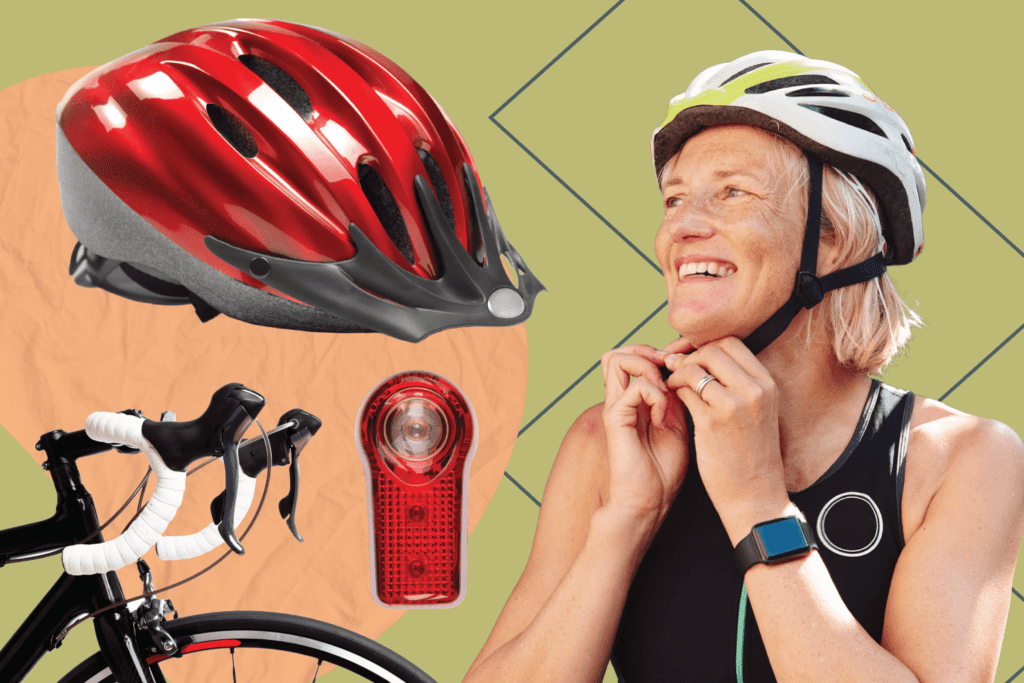


Safety is paramount in any physical activity, including cycling, to prevent injuries and ensure a positive experience.
Listening to your body and seeking professional advice are crucial safety precautions for cyclists:
Listening to Your Body:
Pay attention to any discomfort, pain, or fatigue during rides. Pushing through pain can exacerbate injuries.
Take regular breaks during long rides to rest and stretch your muscles. Avoid overexertion.Gradually increase the intensity and duration of rides to allow your body to adapt.
Stay hydrated and nourished to maintain energy levels and prevent dehydration and fatigue.
Proper Bike Fit:
Ensure your bike is properly fitted to your body size and riding style. An ill-fitted bike can lead to discomfort and injuries.
Adjust saddle height and handlebar position to achieve an ergonomic and efficient riding position.Consider getting a professional bike fit to optimize comfort and performance.
Protective Gear:
Always wear a well-fitted helmet when cycling to protect your head from potential impacts.Consider wearing knee and elbow pads, especially when engaging in more technical or risky off-road rides.
Traffic and Road Awareness:
Obey traffic laws and signals when riding on roads. Use hand signals to indicate turns.Be aware of your surroundings and anticipate potential hazards.Wear bright and reflective clothing to enhance visibility, especially during low-light conditions.
Pre-ride Check:
Before each ride, inspect your bike for any signs of wear or damage. Ensure brakes, tires, and gears are functioning properly.Lubricate the chain and other moving parts regularly to maintain performance and reduce wear.
Seek Professional Advice:
If you experience persistent pain or discomfort while cycling, consult a healthcare professional or sports medicine specialist.
Professional guidance can help diagnose and address underlying issues, as well as recommend appropriate rehabilitation and exercises.
By being attentive to your body’s signals, taking precautionary measures, and seeking expert advice when needed, you can enjoy cycling safely and minimize the risk of injuries.
Always prioritize safety to make the most of your cycling experience and maintain your long-term well-being.
Enjoying Knee-Friendly Cycling for a Healthy Active Lifestyle
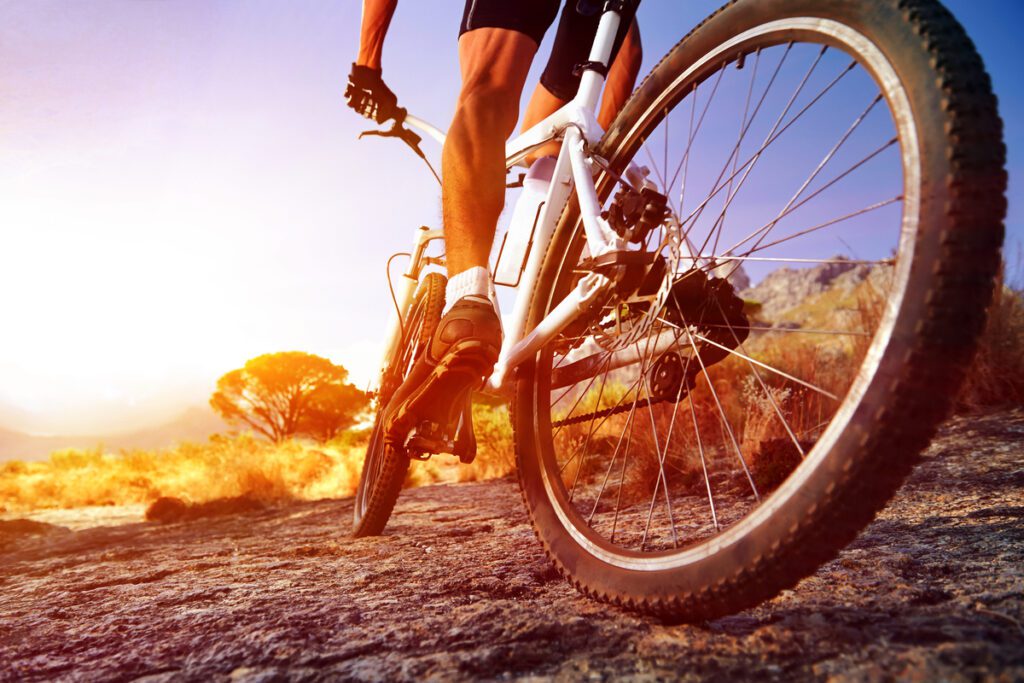


Enjoying knee-friendly cycling is essential to promote a healthy and active lifestyle while safeguarding your knee health.
Here’s a detailed explanation of how to achieve knee-friendly cycling:
Proper Bike Fit:
Start by ensuring your bike is properly fitted to your body size and proportions. A professional bike fit can optimize the bike’s geometry to suit your unique biomechanics, reducing the risk of knee strain.
Low-Impact Terrain:
Choose cycling routes with smooth and level terrain, as it puts less stress on your knee joints compared to rough and uneven surfaces. Avoid excessive downhill rides that can cause strain on the knees.
Cadence Management:
Maintain a comfortable cadence (pedal revolutions per minute) to reduce pressure on the knees. A higher cadence with lower resistance is gentler on the joints than pushing a high gear with slower cadence.
Proper Pedaling Technique:
Learn and practice efficient pedaling techniques. Focus on smooth and circular motions, avoiding sudden or jerky movements that can strain the knees.
Warm-up and Cool-down:
Before starting your ride, warm up your muscles with gentle stretches and movements. After the ride, cool down with stretching exercises to improve flexibility and reduce post-ride stiffness.
Strength and Flexibility Training:
Incorporate strength and flexibility exercises into your routine. Strengthening the muscles around your knees, such as quadriceps and hamstrings, can provide better support and stability.
Cross-Training:
Consider cross-training activities that complement cycling, such as swimming, yoga, or hiking. These activities can help maintain overall fitness and reduce repetitive strain on the knees.
Listen to Your Body:
Pay attention to any discomfort or pain in your knees. If you experience persistent pain or soreness, take a break from cycling and consult a healthcare professional.
Recovery and Rest:
Allow adequate time for recovery between rides, especially after more intense sessions. Giving your knees sufficient rest can prevent overuse injuries.
Proper Nutrition and Hydration:
Maintain a balanced diet and stay hydrated to support your overall health and aid in recovery.
By adopting knee-friendly practices and maintaining good knee health, you can continue to enjoy cycling as a part of your healthy and active lifestyle.
Remember to prioritize safety and listen to your body’s signals for a rewarding and injury-free cycling experience.
Explanation Table
| Aspect | Impact on Knees |
| Impact on Joints | Low impact activity, gentle on knee joints. |
| Muscle Engagement | Promotes balanced muscle development around knees. |
| Cadence Management | Proper cadence reduces stress on knee ligaments. |
| Proper Bike Fit | Ensures proper alignment and reduces strain on knees. |
| Terrain Selection | Smooth surfaces are less harsh on the knee joints. |
| Pedaling Technique | Correct technique distributes effort evenly. |
| Strength Training | Strengthening muscles for better knee support. |
| Cross-Training | Allows knees to recover from cycling motions. |
| Proper Nutrition | Supports overall knee health and recovery. |
| Listening to Body | Helps detect and address knee discomfort or pain. |
| Moderation and Rest | Prevents overuse and promotes knee recovery. |
Cycling, when done with the right techniques and precautions, is generally considered low-impact and not hard on the knees. The table highlights various aspects of cycling and their impact on knee health.
Proper bike fit, cadence management, and choosing suitable terrain are crucial for reducing stress on knee joints. Engaging in strength training and cross-training helps maintain knee support and recovery.
Being mindful of your body and practicing moderation and rest are essential for a positive cycling experience with minimal impact on knees.
Conclusion
In conclusion, biking is generally considered to be a knee-friendly activity when done with proper technique and precautions. The low-impact nature of cycling makes it a great option for individuals concerned about their knee health.
By ensuring a proper bike fit, using the right pedaling technique, and being mindful of terrain, cyclists can reduce the stress on their knees. Regular strength training, cross-training, and proper nutrition further support knee health.
However, it’s essential to listen to your body and seek professional advice if you experience any discomfort or pain.
With responsible biking practices and adequate care, you can enjoy the many benefits of cycling while safeguarding your knees for a healthy and active lifestyle.
FAQ’s
Can cycling damage your knees?
Cycling, when done with proper technique and bike fit, is considered low-impact and generally not harmful to knees. However, improper form or overuse can lead to knee issues.
Is biking harder on your knees than walking?
Biking is generally considered less strenuous on the knees compared to walking, as it is a low-impact exercise that puts less pressure on the knee joints.
Should knees hurt cycling?
Knees should not typically hurt while cycling. Proper bike fit, good pedaling technique, and avoiding excessive strain can help prevent knee pain during cycling.
Which cycle is good for knees?
A properly fitted hybrid bike with a comfortable riding position is generally good for knees, as it offers a balance between road and mountain bike features, reducing strain on the knees.
Does biking strengthen knees?
Yes, biking can strengthen knees when done with proper form and suitable resistance levels. The low-impact nature of cycling helps build knee muscles without excessive stress.



Welcome to Bikegenics, where passion meets performance! We are a leading online destination for all things related to mountain biking, dedicated to providing you with top-notch gear, expert advice, and an immersive community to fuel your two-wheeled adventures. With a commitment to excellence and a deep love for the sport, we strive to elevate your biking experience to new heights.
